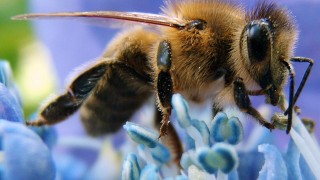
While many of the world’s experts have blamed the mysterious, and disturbing, honeybee decline on a combination of chemicals and disease, biologists may have solved why the pollinating creatures are dying off. It is, they say, down to a single cell organism which acts as a parasite and infects the larvae of the insects.
Beginning in 2006 the overall colony count of honeybees in the United Kingdom, Europe and North America has been reduced and in each year following the numbers of bees are declining dramatically. Various theories blame the dwindling numbers on pesticides and climate change.
Several retail chains in Britain have removed certain chemical pesticides from their shelves in an attempt to bolster the number of bees and prevent further shrinking colonies. Home improvement chains, B&Q (owned by Kingfisher PLC), Wickes (Travis Perkins) and Sainsbury’s Homebase have announced that neonicotinoids; a crop insecticide used on rape, wheat and barley, are also contained in two popular bug sprays carried by the chains and that they will remove these items from their stock.
Studies by the European Food Safety Authority (EFSA) identified the pesticide as have an “unacceptable” effect on not only the bees, citing the chemical as being dangerous, but the general populace as well. It has been pointed out by the Friends of the Earth (FOE) that neonicotinoids are broken down into three different categories; imidacloprid, thiamethoxam and clothianidi; all of which the organization say should be banned. FOE have also stated that they are pleased that the three chains are taking these pesticides out of circulation and have urged other retailers to do the same.
While this can be seen as a step in the right direction by some, the National Farmers Union maintain that there is no evidence that the pesticide is harmful to the honeybees. This information leaves the mysterious decline in honeybee numbers still to be solved except that biologists in the U.S. have discovered a single cell parasite that is fungal and spread by spores. They say that this new parasite is the culprit.
The new endangering parasite is fungal and labelled Nosema ceranae which is widespread and affects the honeybees health in the colony and has been “implicated” in the collapse of the colony as well. Rather interestingly, this parasite is not too dissimilar to the ant “zombie” fungus which is also spread by spores.
According to biology professor James Nieh from San Diego’s University of California, tests initially negated the possibility of the parasites being harmful to the honeybees or their larvae. Nieh said that the previous studies had been based upon “indirect” evidence which rendered the results inconclusive. In a controlled environment using direct samples of larvae exposed to the fungi produced results which proved the parasite was harmful.
The professor revealed that further tests should be made in the field to follow up two recent studies where it was discovered that field colonies were infected after detecting two samples of Nosema DNA in honeybee larvae. Nieh points out that in the past the fungal infection was treated by beekeepers who administered medication. However, it now seems that the infection re-emerges after treatment.
Further studies are being carried out to determine just how the Nosema is being transmitted and whether the brood is infected. This may mean that the declining honeybee mystery has been solved.
